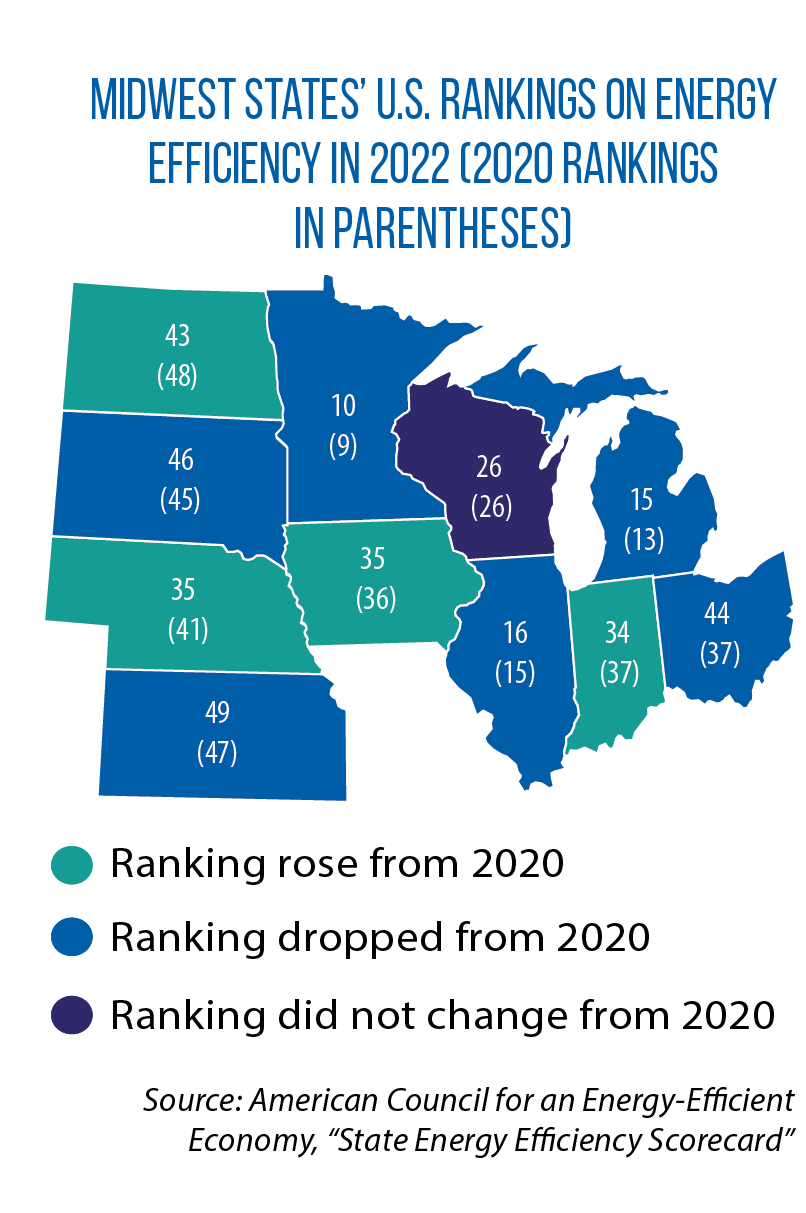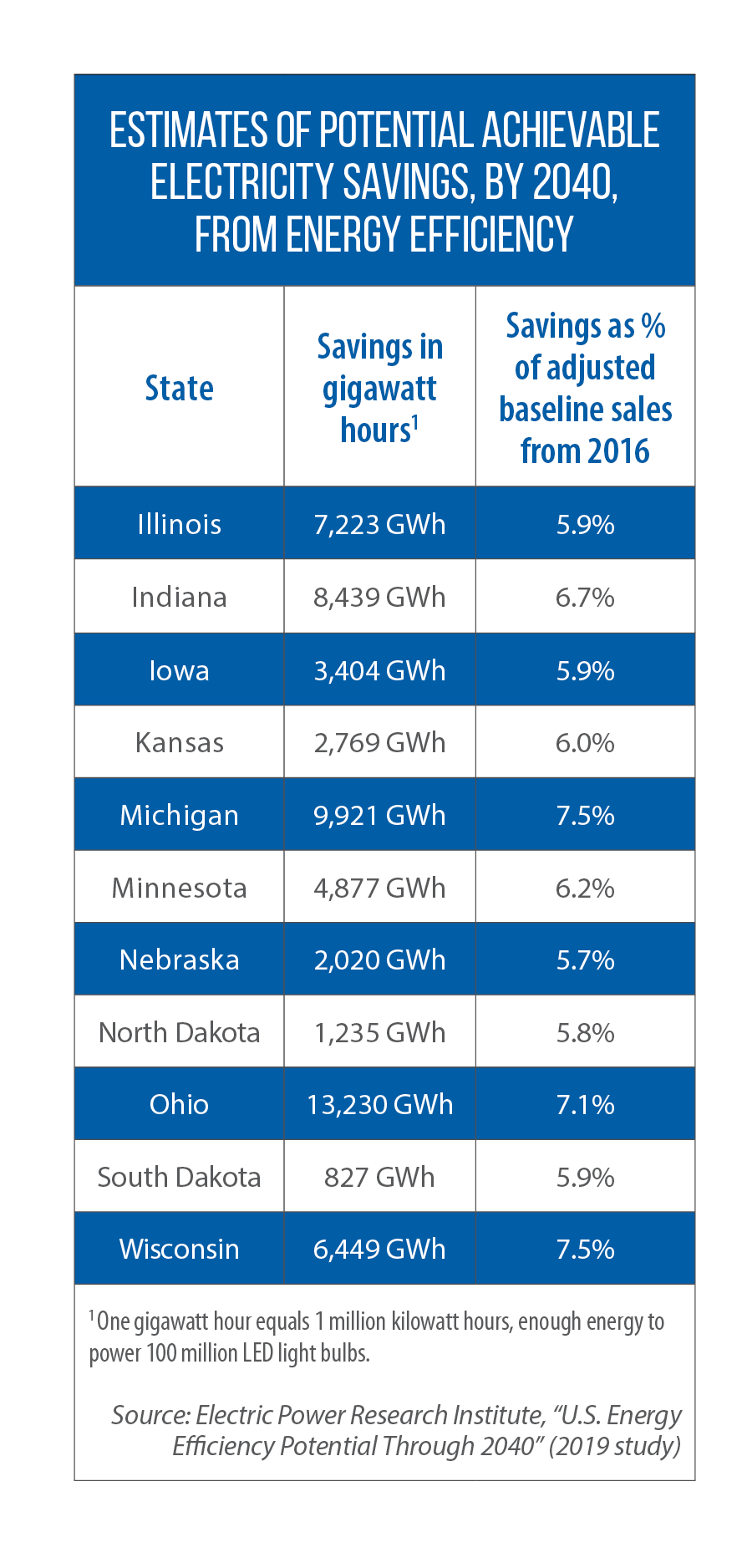A national scorecard on energy efficiency policies puts most Midwest states in bottom half, but Minnesota stands out as regional leader
An electrician by trade, Minnesota Sen. Jason Rarick was naturally drawn to energy topics after being elected to the Legislature in 2014.
It wasn’t long before he got interested in the issue of energy efficiency, at first by helping a local electricity co-operative with a problem it was having with the state’s existing conservation program.
“As I got into it more and more, I saw the benefits [of energy efficiency] for the entire state,” he says.
That led to his sponsorship two years ago of the Energy Conservation and Optimization Act (HF 164) — a far-reaching measure that aims to modernize policy in an area where the state already is a recognized regional leader.
Among its key provisions:
• Increase the state’s energy savings goal, from 1.5 percent to 2.5 percent.
• Give utilities more options in implementing their ratepayer-funded Conservation Improvement Programs (CIP), the state’s longtime mechanism for ensuring a revenue source for energy-efficiency projects and incentives.
• Require investor-owned utilities to spend more on efficiency programs for low-income customers.
When the measure passed in 2021, it was hailed as one of the year’s biggest breakthroughs by Minnesota’s partisan-split Legislature.
“The best way to cut carbon emissions is to not make them in the first place,” says Minnesota Rep. Zack Stephenson. A Democrat, Stephenson served as chief author of the House bill; Rarick, a Republican, was the lead author and sponsor in the Senate.
Minnesota stands out in a region where most states lag behind other parts of the country on energy efficiency policies, says Martin Kushler, senior fellow at the American Council for an Energy-Efficient Economy (ACEEE).
Kushler believes the Midwest would benefit by trying to catch up.
“The economics are just so solid and so good for customers,” he says.
“The Midwest states are almost all entirely dependent on imported sources of fuel (oil, coal, natural gas); that’s literally a dollar drain of billions of dollars a year from their states. If you can be energy-efficient, you’re going to reduce that dollar drain.
“And that benefits everybody.”
The ACEEE, a nonprofit research organization, produces an annual scorecard of all 50 states based on its analysis of policies in areas such as:
• building codes and appliance standards;
• the efficacy of utility-based public benefits funds, which provide long-term funding (via a surcharge on customers’ electricity bills) to meet energy-conservation goals; and
• initiatives to improve efficiency in a state’s transportation system as well as among state entities themselves.
The 2022 scorecard, released in December, ranks Minnesota 10th nationally, highest in the 11-state Midwest.
Illinois fell to No. 16 despite enactment of the Clean Energy Jobs Act in 2021, a sweeping law that puts the state on track for carbon-free electricity by 2045, provides new electric vehicle adoption and manufacturing incentives, and includes new programs to help low-income residents with energy efficiency.
Michigan fell to 15th place, but was singled out as a “state to watch” due to the rollout of its “MI Power Grid” Initiative (see map for all Midwestern states’ U.S. rankings).
Minnesota modernizes its efficiency policies
Minnesota earned its top regional ranking in part on the strength of the 2021 law. As part of the ECO Act’s modernization of the state’s longstanding Conservation Improvement Program, utilities now have the authority to include in their plans “efficient fuel-switching” — offering incentives and rebates to customers who change their fuel source to one that reduces energy use and greenhouse gas emissions.
The law also gives utilities more financial options to improve load management via projects that shift energy demand from peak times (when electricity is most expensive) to less-expensive times of the day.
Other provisions require efficiency improvements for public schools in a utility’s plans and expand eligibility for programs serving low-income customers residing in multi-family buildings (five or more units).
Greater efficiencies through utility conservation plans is one way that Minnesota plans to meet its new, and higher, overall energy-savings goal of 2.5 percent (previous annual electricity sales are used as a baseline to measure the savings).
Advances in building codes, savings from rate design, and infrastructure improvements also can contribute to this overall goal.
Enactment of the ECO Act ended a six-year journey that included its main legislative sponsors, Stephenson and Rarick, almost from the moments they joined their respective chambers.
Both legislators say they’re pleased with its implementation to date; neither expects any trailer bills in 2023.
Rarick says additional legislation is more likely to come as new energy storage technologies and fuels such as hydrogen emerge. “We may need to help things along” or allow utilities to adopt them, he adds.
Stephenson, however, says he’s open to further efficiency efforts during the 2023 session.
According to the Minnesota Department of Commerce, the Conservation Improvement Program generates at least $4 in energy savings for every $1 invested by utilities.
Typical CIP activities for residential customers include energy audits and incentives and rebates for energy-related improvements, from high-efficiency lighting, insulation and air sealing, to the purchase of new, more efficient furnaces, air conditioners and water heaters.
For business customers, utilities may offer rebates for high-efficiency boilers, chillers and rooftop units, motors, lighting and lighting control systems; they also provide design assistance for energy-efficient buildings and technical assistance to reduce the energy intensity of manufacturing processes.
Michigan prepares power grid for clean energy
The MI Power Grid Initiative, launched in October 2019 by the Michigan Public Service Commission, aims to ease the transition to clean energy for customers, utilities and regulators by updating the commisson’s oversight of electricity.
“We’re in the midst of a pretty significant energy transition, including from large, centralized plants to more distributed energy resources; for example, home solar systems that can add surplus energy back into the electrical grid,” says Dan Scripps, commission chair.
One of the first steps under the initiative has been to analyze how the rise of distributed energy resources impacts the state’s electrical grid and to explore potential regulatory responses. A report on next steps for the state will be finalized in 2023.